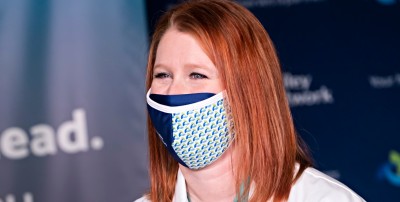
For the most-recent information, please visit LVHN.org/vaccines.
When you receive a COVID-19 vaccine, your immune system goes to work creating antibodies to protect itself from the coronavirus. The vaccine CANNOT cause a COVID-19 infection but can cause side effects, including pain at the injection site, tiredness, headache, muscle pain, chills, joint pain and fever. Pfizer has reported that some Phase III clinical trial participants experienced mild to moderate flu-like side effects, including sore arm, muscle aches and fever.
“Most side effects from the vaccine are driven by the stimulation of the immune system,” says Timothy Friel, MD, Chair, Department of Medicine, with Lehigh Valley Health Network (LVHN). “Ultimately, symptoms such as sore arms, muscle aches, fever and headaches mean that your immune system is responding to the vaccine and producing antibodies that will protect against future infection with coronavirus.”
A few weeks ago, we told you how some LVHN front-line colleagues felt after receiving their first dose of COVID-19 vaccine. As anticipated, some of these colleagues experienced more noticeable side effects than they did after their first dose, which is normal.
This is consistent with the findings identified in the vaccine clinical trials and can be expected in some vaccine recipients. These side effects generally occur within the first three days after the second dose. Note: Day one is the day you receive the vaccine.
Here's what colleagues are saying after their second shot
“The first shot was a breeze and felt no different than my annual flu vaccine. Shot number two came with a kick! I got my second shot on Wednesday at noon and felt mild pain at the injection site. Later that evening my axillae (armpit) was sore as if I had been pulling on a machine cord for a long time. The next day, about 18-20 hours after my shot, I felt chills, myalgias (body aches) and extreme fatigue as if I were finishing a long race. I did not get a fever, but I did experience chills.
“When I got home, I hydrated, took ibuprofen and did a short yoga session (because my wife insisted), and I was in bed by 9 p.m. I felt fine the next day.” – Marcelo Gareca, MD, LVPG Infectious Diseases
“I did OK with the second shot. I had some body aches for about 24 hours afterwards, along with some arm soreness. It did not keep me from my normal activities, and I felt better within 48 hours.” – Chantal Branco, RN, LVHN Patient Care Services
“Twenty-four hours after my shot, I only had some mild soreness in my left arm – that’s it. I did have mild chills 36 hours after the injection.” – Charles Worrilow, MD, LVPG Emergency Medicine
“After my second COVID-19 vaccine, I had the expected sore arm. However, I also awoke the next morning with muscle aches all over, felt pretty tired and just a bit nauseous. It was about 24 hours from the time I received the vaccine, and with the help of ibuprofen in the morning, I felt close to normal again. Even with how I felt the morning after my shot, I would still choose to do it all over knowing this vaccine is bringing us closer to turning the corner in the pandemic.” – Jennifer Rovella, DO, LVPG Pulmonary and Critical Care Medicine
“I had a ‘strong immune response’ to the vaccine. I had a fever of 102.5, body aches and chills, as well as arm discomfort at the injection site. The fever subsided in about half a day, but other symptoms lingered for another day. Oddly it didn’t limit me too much. I did stay home and rest, but I wasn’t flat on my back. I feel fine now, and between the choice of getting COVID-19 or the vaccine, I would still choose the vaccine. People should know that they may have a short-lived reaction to the vaccine and prepare for it.” – Glenn Thompson, RN, LVHN Emergency Services
Know the difference between vaccine side effects and COVID-19 symptoms
If you experience cough, sore throat, shortness of breath, or loss of taste or smell, stay home. Those symptoms are not known to be side effects associated with the vaccine. It may be difficult to distinguish between some side effects of the vaccine and symptoms of COVID-19 or other illnesses. When in doubt, speak to a provider virtually. You can view virtual care options at LVHN.org/VirtualCare.
Preregister for a COVID-19 vaccine
MyLVHN is your path to vaccination. The first step you can take is to enroll in MyLVHN if you don’t already have an account. Everyone with a MyLVHN account will automatically be preregistered for a COVID-19 vaccine. MyLVHN is a free, secure, easy-to-use patient portal that connects you with your personal health information. You do not need to be a current patient of LVHN, LVPG or Coordinated Health to open a MyLVHN account. Learn more at LVHN.org/MyLVHN.
If you already have an account, make sure all your information is up to date. (Log in and click "Menu," "Account Settings," and then edit your personal information.) You’ll receive a notification when it's your turn to get vaccinated and you are able to schedule your appointment through MyLVHN.
